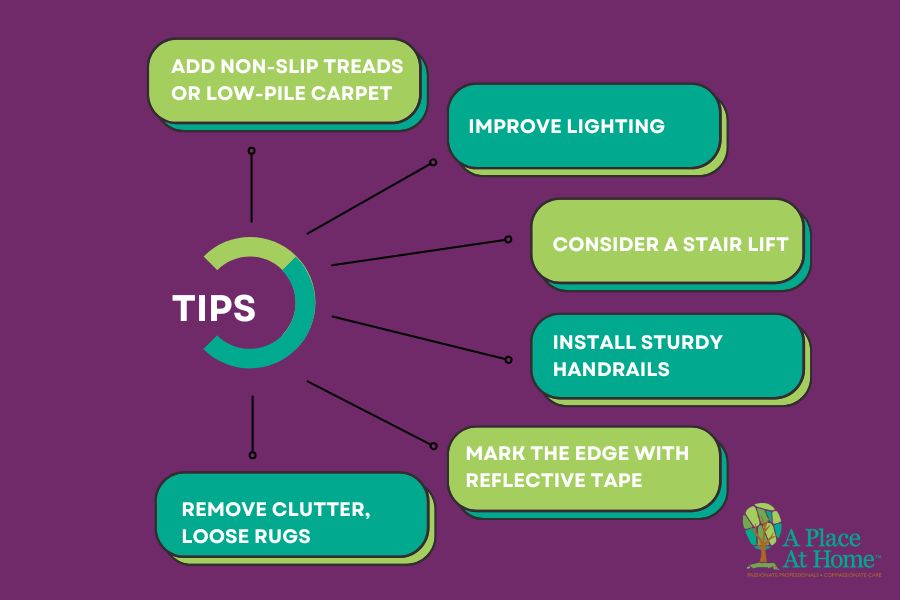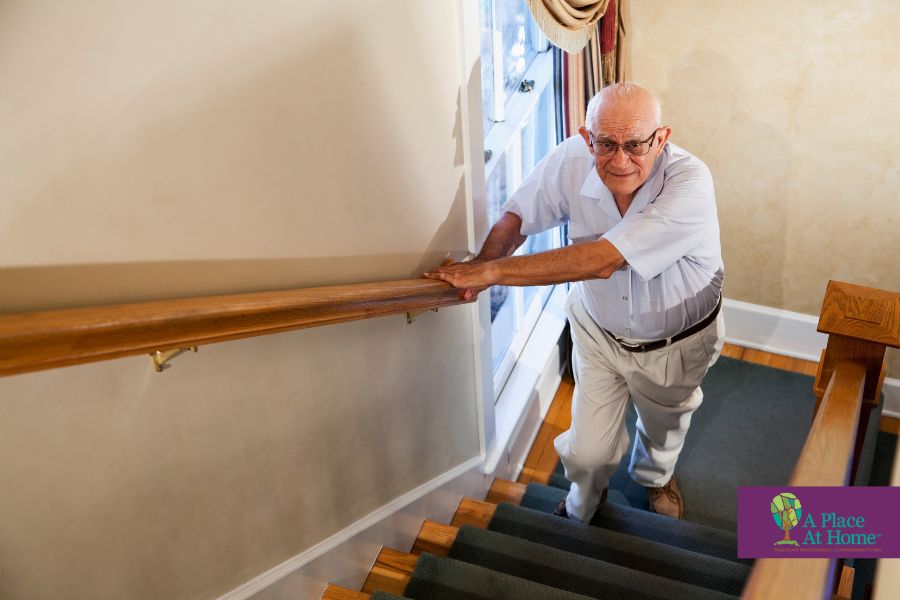If your senior loved one hopes to age safely in their own home, ensuring a secure living environment is essential. One of the most important areas to focus on is the stairs—whether they lead to a basement, a second-floor bedroom, or even a backyard. Stairs can pose a significant risk of falls, so taking steps to make them safer is a crucial part of protecting your loved one’s independence and well-being.
For families in Weston and the surrounding Broward County communities, many homes are multistory. That makes stair safety especially important for older adults who want to remain in the comfort of their own home.
How Stairs Can Be Dangerous for Seniors
In the United States, more than 1 million people are injured on stairs each year, an average of about 3,000 injuries per day, or one every 30 seconds. The risk of stair-related injuries increases as we age, due to decreased coordination, reduced strength, and changes in vision, all of which can make navigating stairs more challenging.
Research shows that adults aged 60 and older are at a higher risk of hospitalization from stair-related injuries. Certain health conditions can further increase this risk. For example, osteoporosis can make bones more fragile, while anticoagulant medications can lead to serious complications such as intracranial bleeding if a fall occurs.
Falls can also be triggered by a variety of underlying issues—balance problems, medication effects, chronic pain, or neurological changes. To better understand the most common reasons seniors experience falls, you can read our resource on Why Seniors Keep Falling.
Stairs are common in American homes, with more than half of all houses containing them. In some regions, like New England and the Middle Atlantic, more than 90 percent of homes are multistory, making stair safety an important concern for older adults.
Quick Ways to Make Stairs Safer for Seniors
If you are worried about your loved one’s safety on the stairs, here are some simple changes that can have a big impact:
- Add non-slip treads or low-pile, tightly fitted carpet
- Improve lighting at the top and bottom of the staircase
- Install sturdy handrails on both sides of the stairs
- Mark the edge of each step with contrasting or reflective tape
- Remove clutter, loose rugs, and decorative objects
- Consider a stair lift if your loved one frequently avoids the stairs
These changes, combined with regular supervision and support, can greatly reduce the risk of stair-related falls.
How to Make Stairs Safer for Seniors at Home

Falls can have serious consequences for older adults, which is why it’s so important to be proactive in reducing the risk. One of the most effective ways to do this is by making thoughtful design and environmental changes in the home. Here are some practical strategies to make stairs safer for seniors:
Add Traction to the Stairs
Most stair-related injuries occur from slipping rather than tripping, which makes reducing slipperiness a top priority. If your stairs are made of wood or tile, consider adding materials that increase traction, such as:
- Rubber or abrasive stair treads
- Anti-slip tape
- Skid-resistant floor treatments
Low pile carpeting that is tightly fitted and securely attached can also help prevent slips. Additionally, encourage your senior loved one to wear proper footwear with a firm, rubber sole when using the stairs to further reduce the risk of falls.
Light Up the Stairs
Poorly lit stairs significantly increase the risk of slips and injuries, and in many homes, stairwells are more dim than other areas. Installing bright, even lighting makes it easier for your senior loved one to see each step, especially at the top and bottom, where most falls occur. Ideally, there should be a light switch at both the top and bottom of the staircase, or one can be installed if it’s not already in place. For added safety, consider wall-mounted, wireless motion-sensing night-lights positioned at foot and ankle level to guide each step in low-light conditions.
Increase Visual Cues
If your senior loved one has difficulty distinguishing individual steps, especially when the stairs are all the same color, adding reflective or colored tape to the edge of each step can help them see where one step ends and the next begins. Another option is to paint the vertical portion of wooden steps (the risers) white or a contrasting color, which clearly separates the tread, the part of the step meant for stepping, from the riser and makes each step easier to navigate.
Ensure Consistent Height and Depth
To help prevent tripping, it’s important that both the horizontal (tread) and vertical (riser) surfaces of each step are uniform in size. Stairs with inconsistent widths or varying heights can easily cause missteps, especially for seniors who may have reduced coordination or depth perception. Ensuring that every step is the same size and shape creates a predictable, safe surface that makes navigating the stairs much easier and reduces the risk of falls.
Get Rid of the Bottom-Step Illusion
In some older homes, the bottom step can blend in with the landing, creating a potential hazard. An elderly person may mistakenly think they are stepping onto a flat surface, increasing the risk of a fall. To prevent accidents, it’s important to clearly distinguish the bottom step from the rest of the landing. This can be done by adding a rubber tread or anti-slip tape, or by upgrading the step to match the design and color of the other stairs, making it easier to see and safely navigate.
Make Upgrades to the Handrails
Handrails are a crucial safety feature in any home, as they provide support, improve balance, and help prevent falls on stairs. Unfortunately, in many homes, they are more decorative than functional. For maximum safety, handrails should be rounded so that a hand can fully grasp and encircle them. Consider installing rails on both sides of the staircase, running the full length of the stairs, and positioned 30 to 36 inches above the floor. Properly installed handrails give seniors the stability they need to navigate stairs safely.
Remove Clutter
It’s important to keep stairways completely clear of clutter to eliminate any risk of tripping or falling. Items such as shoes, books, or decorative objects should never be left on the stairs, and any throw rugs should be removed, as they can easily slip or bunch up underfoot. Maintaining a clean, unobstructed pathway ensures that your senior loved one can navigate the stairs safely and with confidence.
Install a Stair Lift If Needed
If your senior loved one has significant difficulty navigating stairs, a motorized stair lift may be a practical solution. These lifts typically cost between $2,000 and $10,000, and in some cases, you may be able to claim part of the expense through insurance. Installation is usually completed in a single day, but it’s important to ensure that the stairway is wide enough to accommodate the chair while still allowing others to use the stairs safely. The lift can also be easily removed if you decide to sell the home, making it a flexible option for improving stair safety.
Professional Senior Home Care from A Place At Home
While making stairways safer is a critical step in preventing falls, it’s only one part of keeping your senior loved one safe and independent at home. Regular supervision, assistance with daily activities, and professional guidance can provide an added layer of protection and peace of mind.
At A Place At Home – Weston, our experienced caregivers are trained to support seniors in their homes, including:
- Safe mobility and transfers on and around stairs
- Support with personal care and daily tasks
- Encouraging safe footwear and use of handrails
- Monitoring for changes in balance, strength, or confidence
We work with families in Weston and nearby Broward County communities to create customized care plans that prioritize safety, independence, and quality of life while helping to prevent falls.
If you want to ensure your loved one can move safely around their home and reduce the risk of stair-related accidents, contact A Place At Home – Weston at (954) 451-0848. Our caregivers provide compassionate senior home care and fall prevention support in the Weston, Davie, Pembroke Pines, and Hollywood, FL area to help keep your senior loved ones safe at home.
Frequently Asked Questions About Stair Safety for Seniors
Are there times when seniors should avoid using stairs altogether?
Yes. It may be safer to limit or stop stair use if your loved one has had a recent fall, surgery, or hospitalization, or if they have severe balance problems, dizziness, advanced arthritis, or serious heart or lung issues. In these cases, temporarily arranging a bedroom and bathroom on the main level, using a stair lift, or having a caregiver assist on the stairs can help reduce risk.
Muscle tightness, nighttime pain, or sudden leg cramps can also make stair use more difficult for older adults. If your loved one experiences this, you may find our guide on 7 Ways to Relieve Nighttime Leg Cramps in Seniors helpful.
Can dementia or memory loss increase the risk of falls on stairs?
Yes. Seniors living with Alzheimer’s or other forms of dementia may misjudge step height, forget to use the handrail, become distracted mid-staircase, or feel confused in dim lighting. Adding strong lighting, clear visual contrast on each step, and supervision or standby assistance on the stairs can be especially important for those with memory loss.

